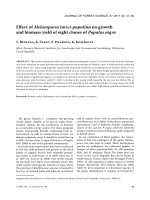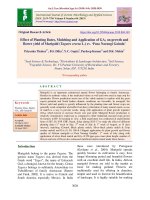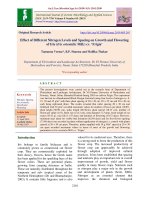Effect of plant residues on growth and seed yield of soybean
Bạn đang xem bản rút gọn của tài liệu. Xem và tải ngay bản đầy đủ của tài liệu tại đây (171.83 KB, 6 trang )
Int.J.Curr.Microbiol.App.Sci (2019) 8(4): 490-495
International Journal of Current Microbiology and Applied Sciences
ISSN: 2319-7706 Volume 8 Number 04 (2019)
Journal homepage:
Original Research Article
/>
Effect of Plant Residues on Growth and Seed Yield of Soybean
S. Ravi1*, R.L. Jadhav2, S.N. Bhat1 and Anand Kamble2
1
Department of Soil Science and Agricultural Chemistry, 2Department of Agronomy, KVK,
Bidar, UAS, Raichur, Karnataka, India
*Corresponding author
ABSTRACT
Keywords
Seed yield, Haulm
yield, Plant height,
Plant residues,
Soybean
Article Info
Accepted:
07 March 2019
Available Online:
10 April 2019
An experiment was conducted during Kharif 2012 and 2013 at Krishi Vigyana Kendra,
Janwada, Bidar, University of Agricultural Sciences, Raichur, Karnataka, India. To assess
the growth, yield and economics of soybean as influenced by the application of plant
residues under rainfed situation of Northern Karnataka. Results revealed that, application
of RDF (40:80:25 NPK kg/ha + 12 kg ZnSO 4/ha + 20 kg sulphur/ha) + plant residues at
3.0 tonnes/ha recorded significantly (p=0.05) higher haulm and seed yield (3007 and 2269
kg/ha, respectively) and which was on par with the application of RDF + plant residues at
2.25 tonnes/ha (2839 and 2136 kg/ha, respectively). Further, Application of RDF + plant
residues at 0.75, 1.5 and 2.25 tonnes/ha were at par with each other with respect to haulm
and seed yield. Whereas, significantly least haulm and seed yield were recorded in control
treatment.
(40 %) and oil (20 %) having a vast
multiplicity of uses as food and industrial
products (1).
Introduction
Soybean (Glycine max (L.) Merrill) in India is
cultivated over an area of 9.4 million ha with
production of 9.6 million tons and is known
as “Golden Bean” of 20th century. Though
soybean is a legume crop, yet it is widely
used as an oilseed. It is now occupying first
place among all the oilseed crops in India
followed by rapeseed mustard and groundnut,
respectively. It grows in varied agro-climatic
conditions. Due to its world- wide popularity,
the international trade of soybean has spread
globally. Soybean possesses a very high
nutritional value and is the richest, cheapest
and easiest source of the best quality proteins
Producers have expressed concerns about
production practices where high levels of crop
residue are present on the soil surface. These
concerns include wetter soil and lower soil
temperatures delaying planting and retarding
plant development during early vegetative
growth, and less uniform germination and
emergence using planting equipment that
cannot operate adequately in the residue. By
the reproductive growth stage, however,
vegetative growth of crops under no till
management can catch up to the growth of
490
Int.J.Curr.Microbiol.App.Sci (2019) 8(4): 490-495
crops under tilled management (2). Another
benefit of crop residue is that it reduces the
energy of water droplets impacting the soil
surface, thereby reducing the detachment of
fine soil particles that tend to seal the surface
and lead to crust formation. This sealing and
crusting process can be enhanced by
subsequent soil surface drying, and it reduces
infiltration and promotes runoff because
precipitation or irrigation rates may be greater
than the rates at which the soil is able to
absorb water. Residue may increase surface
storage of rain or irrigation water. In addition,
it slows the velocity of runoff water across the
soil surface, allowing more time for
infiltration (3).
clay loam, slightly saline (pH 8.36), high in
organic carbon (0.53 %), available nitrogen
(268.0 kg N/ha), phosphorus (30.6 kg
P2O5/ha) and potassium (423 kg K2O/ha).
Treatments details
The experiment was comprises of six
treatments viz., T1: Absolute Control, T2: RDF
(40:85:25 kg NPK + 12 kg ZnSO4+20 kg
Sulphur/ha), T3: RDF + Plant residue at 0.75
tonnes/ha, T4: RDF + Plant residue at 1.50
tonnes/ha, T5: RDF + Plant residue at 2.25
tonnes/ha and T6: RDF + Plant residue at 3.0
tonnes/ha.
Experimental details
Bidar District of Karnataka (India) is
dominated by red lateritic and medium to
deep black soils and these soils are poor in
soil fertility due to deficiency of secondary
and micronutrients. Soybean is one of the
important oil seed crop and it is being grown
in an area of 95,000 ha with a production of
33,250 thousand tonnes with an average
productivity of 725 kg/ha. Since, the yields
are low as compared to state average (950
Kg/ha). Intensive cropping, indiscriminate use
of fertilizers and limited use of organic matter
and plant residues are the reasons for limits
soybean yield. However, very meager
information is available on effect of plant
residues on soybean yield. Hence a field
experiment was conducted to investigate the
effect of plant residues on soybean yield in
Northern Karnataka.
The experiment was laid out in randomized
complete block design with four replications.
Soybean variety JS 335 was grown at a row
spacing of 45 cm. Crop received
recommended dose of nutrients @ 40:80:25:
kg N: P2O5: K2O per ha through urea, diammonium phosphate and muriate of potash,
respectively. Sulphur and Zinc sulphate were
applied as per treatment details through
gypsum (18 % S) and Zinc sulphate,
respectively. Soybean seed were inoculated
with Bradyrhizobium japonicum culture @ 5
g per kg seed. The crop resides was applied as
per the treatment after the germination of
crop. The rainfall received during kharif 2012
and 2013 was 850 mm and 940 mm,
respectively. Other crop management
practices
were
performed
as
per
recommended package of practices.
Materials and Methods
Data collection and economics
Background of the study
The observations on growth parameters/
attributes like plant height, branches per plant
and pods per plant were taken on five
randomly selected plants from each treatment
at harvest. Observation on seed index was
taken and expressed as g per 100 seed. After
An experiment was carried out during Kharif
2012 and 2013 at Krishi Vigyana Kendra
(KVK), Janwada, Bidar, University of
Agricultural Sciences, Raichur, Karnataka,
India. The soil of the experimental field was
491
Int.J.Curr.Microbiol.App.Sci (2019) 8(4): 490-495
harvest and threshing of crop, seed yield was
recorded in net plot wise and converted to
grain yield per hectare basis. The cost of
inputs that were prevailing at the time of their
use was considered for working out the
economics of various treatments. Net return
per hectare was calculated by deducting the
cost of cultivation from gross returns per
hectare, gross returns was calculated by using
the total income obtained from grain and
straw yield of rice and the benefit cost ratio
was worked out as follows.
with each other with respect to plant height
and number of branches per plant. This might
be due to high accumulation of net
photosynthates. The results obtained are
consistent with findings reported by Meena et
al (5). However, significantly (p=0.05)
shorter plants and least number of branches
were recorded in control.
Effect of plant residues on yield and yield
parameters of soybean
Yield attributes like number of pods per plant,
seed index, haulm and seed yield showed a
significant variation for different rate of
application of plant residues along with
recommended dose of fertilizer application
(Table 2). Results revealed that, 100 seed
weight significantly did not differ with
different rate of application of plant residues.
Application of RDF (40:80:25 NPK kg/ha +
12 kg ZnSO4/ha+ 20 kg sulphur/ha) + plant
residues
at
3.0
tonnes/ha
recorded
significantly (p=0.05) higher haulm and seed
yield (3007 and 2269 kg/ha, respectively) and
which was onpar with the application of RDF
+ plant residues at 2.25 tonnes/ha (2839 and
2136
kg/ha,
respectively).
Further,
Application of RDF + plant residues at 0.75,
1.5 and 2.25 tonnes/ha were atpar with each
other with respect to haulm and seed yield.
This might be due to the favourable role of
nutrients and moisture storage due to
mulching with plant residues in nodulation
and seed formation process. The results are in
consistent with the findings of Saxena and
Nainwal (6) who reported that seed and haulm
yield increased significantly with incremental
dose of sulphur and boron application.
Application of crop residues on soil may
conserve the soil moisture content and
reduces the weed population. Therefore, the
yield of soybean has been drastically
increased. Plant residues acts as a mulching
so that, it favours the plant growth.
Gross returns (`/ha)
Benefit cost ratio =
Cost of cultivation (`/ ha)
Data analysis
MSTAT was used for statistical analysis of
data and means were separated using critical
difference (CD) at p=0.05. The data on weeds
were
transformed
by
square
root
transformation before being subjected to
ANOVA (4).
Results and Discussion
Effect of plant residues
parameters of soybean
on
growth
Results revealed that, Plant height and
number of branches per plant showed a
significant (p=0.05) variation with different
rate of application of plant residues along
with recommended dose of fertilizer
application (Table 1). Application of RDF
(40:80:25 NPK kg/ha + 12 kg ZnSO4/ha+ 20
kg sulphur/ha) + plant residues at 3.0
tonnes/ha recorded significantly (p=0.05)
taller plants (64.0 cm) and maximum
branches (60.7) and which was onpar with the
application of RDF + plant residues at 2.25
tonnes/ha (6.05 and 5.20, respectively).
Further, Application of RDF + plant residues
at 0.75, 1.5 and 2.25 tonnes/ha were at par
492
Int.J.Curr.Microbiol.App.Sci (2019) 8(4): 490-495
Table.1 Effect of plant residues on growth parameters of soybean
Treatments
Plant height (cm)
Branches/plant
Pods/plant
2012
2013
Pooled
2012
2013
Pooled
2012 2013
Pooled
T1: Control
43.4
42.9
43.2
2.6
2.8
2.7
40
43
41.5
T2: RDF
54.3
55.2
54.8
3.9
3.6
3.75
59
62
60.5
T3: RDF + Plant residue at
0.75 tonnes/ha
55.9
57.6
56.7
4.1
4.3
4.2
60
65
62.5
T4: RDF + Plant residue at
1.50 tonnes/ha
57.4
59.7
58.6
4.6
4.9
4.75
71
73
72.0
T5: RDF + Plant residue at
2.25 tonnes/ha
59.9
61.6
60.7
5.3
5.1
5.20
79
80
79.5
T6: RDF + Plant residue at
3.0 tonnes/ha
63.2
64.8
64.0
6.1
6.0
6.05
83
84
83.5
C.D.(P=0.05)
6.72
8.84
7.78
0.85
0.88
0.86
7.73
9.32
8.52
RDF: 40:80:25 NPK kg/ha + 12 kg ZnSO 4+ 20 kg sulphur
Table.2 Effect of plant residues on yield and yield parameters of soybean
Treatments
100 Seed weight (g)
Haulm yield (kg/ha)
Seed yield (kg/ha)
2012
2013
Pooled
2012 2013
Poole
d
2012
2013
Pooled
T1: Control
11.80
11.45
11.63
1138 1182
1160
925
961
943
T2: RDF
12.60
12.92
12.76
2383 2404
2393
1875
1893
1884
T3: RDF + Plant residue
at 0.75 tonnes/ha
13.68
13.23
13.45
2513 2695
2604
1963
1990
1977
T4: RDF + Plant residue
at 1.50 tonnes/ha
13.80
13.56
13.68
2633 2801
2717
2041
2102
2072
T5: RDF + Plant residue
at 2.25 tonnes/ha
13.83
13.87
13.85
2783 2895
2839
2125
2148
2136
T6: RDF + Plant residue
at 3.0 tonnes/ha
13.98
14.10
14.04
2959 3054
3007
2259
2279
2269
NS
NS
NS
333.
9
361
281.8
264.
5
273.1
C.D.(P=0.05)
RDF: 40:80:25 NPK kg/ha + 12 kg ZnSO4+ 20 kg sulphur
493
387.
4
Int.J.Curr.Microbiol.App.Sci (2019) 8(4): 490-495
Table.3 Economics of soybean as influenced by the application of plant residues (Mean of 2012
and 2013)
Treatment
T1: Control
T2: RDF
T3: RDF + Plant residue at
0.75 tonnes/ha
T4: RDF + Plant residue at
1.50 tonnes/ha
T5: RDF + Plant residue at
2.25 tonnes/ha
T6: RDF + Plant residue at
3.0 tonnes/ha
C.D. (P=0.05)
Cost of
cultivation (Rs.)
26975
32077
32565
Gross Returns
(Rs.)
40362
79506
83580
Net Returns (Rs.)
B:C
13387
47429
51015
1.50
2.48
2.56
33052
88284
55232
2.67
33540
90216
56676
2.69
34027
95718
61691
2.81
NA
NA
4256
0.11
RDF: 40:80:25 NPK kg/ha + 12 kg ZnSO 4+ 20 kg sulphur
It may be concluded that, application of RDF
(40:80:25 NPK kg/ha + 12 kg ZnSO4/ha+ 20
kg sulphur/ha) + plant residues at 3.0
tonnes/ha or 2.25 tonnes/ha may enhance the
growth, seed yield of soybean and B:C ratio
and this method proved most economical in
Northern Karnataka.
Economics of soybean as influenced by the
application of plant residues
Economic evaluation (Table 3) revealed that,
the maximum net returns (` 61691/ha) and
benefit cost ratio (2.81) were obtained with
the application of RDF (40:80:25 NPK kg/ha
+ 12 kg ZnSO4/ha+ 20 kg sulphur/ha) + plant
residues at 3.0 tonnes/ha and which was
closely followed by the application of RDF+
plant residues at 2.25 tonnes/ha (` 56676/ha
and 2.69, respectively) compared to other
treatments.
References
1. Anonymous. 2016. Director’s Report and
Summary Tables of Experiments
(2014- 2015), All India Coordinated
Research Project on Soybean, Indore.
2. Klocke, N. L., D. F. Heermann, and H. R.
Duke.
1985.
Measurement
of
evaporation and transpiration with
lysimeters. Trans. ASAE 28(1): 183189, 192.
3. Steiner, J. L. 1994. Crop residue effects
on water conservation. In Managing
Agricultural Residues, 41-76. P. W.
Unger, ed. Boca Raton, Fla.: CRC
Press.
4. Gomez, K.A. and A.A. Gomez, (1984).
Statistical procedures for agricultural
research (2 ed.). John Wiley and sons,
NewYork, 680p
Further, least net returns and benefit cost ratio
was observed in absolute control. These
results are conformity with the findings of
Singh, et al (7) stated that, the maximum net
returns (`20,115/ha) were obtained with 40 kg
S per ha, which was significantly superior
over control, but at par with 30 kg S per ha.
Similarly, application of 2.0 kg B per ha
recoded maximum net returns (19,591/ha),
which was significantly superior to 0.5 kg B
per ha and control, but was on par with 1 kg
and 1.5 kg B per ha. The highest B: C ratio of
1.98 was recorded with the application of 30
kg S per ha.
494
Int.J.Curr.Microbiol.App.Sci (2019) 8(4): 490-495
5. Meena, D S, Ram B and Tetarwal, J P.
2011. Productivity, quality and
profitability of soybean (Glycine max
L.) as influenced by sulphur and boron
nutrition. Soybean Research 9: 103108.
6. Saxena, S C and Nainwal, R C. 2010.
Effect of sulphur and boron nutrition
on yield, yield attributes and
economics of soybean. Soybean
Research 8: 7-12.
7. Singh, A. K., Singh, C. S. and Yadava, J.
P., 2013, Response of Soybean to
Sulphur and Boron Nutrition in Acid
Upland Soils of Jharkhand. Soybean
Research 11(2): 27-34
How to cite this article:
Ravi, S., R.L. Jadhav, S.N. Bhat and Anand Kamble. 2019. Effect of Plant Residues on Growth
and Seed Yield of Soybean Int.J.Curr.Microbiol.App.Sci. 8(04): 490-495.
doi: />
495








![Effect of precision farming techniques involving fertigation and mulching on growth attributes and seed yield of okra var. Arka Anamika [Abelmoschus esculentus (L.) Moench]](https://media.store123doc.com/images/document/2020_01/14/medium_ynr1578936108.jpg)
